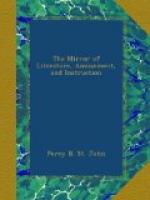“From the death of Elizabeth, until after the restoration of Charles II., the turbulence of the times, and the peculiar character of the age, prevented this art, which flourishes only in ’the bowers of peace and joy,’ from making much progress; but in the days of the merry monarch it began to revive, and advanced more, or less, in all the succeeding reigns. The celebrated Beau Nash, who was, for a long time, M.C. at Bath, may be considered the founder of modern ball-room dancing; which, however, has been divested of much of its cold formality, and improved in various other respects since the time of that singular person. It is, nevertheless, a matter of regret, that the graceful and stately Minuet has been entirely abandoned in favour of the more recently-invented dances.
“The French country dances, or Contre-Danses (from the parties being placed opposite to each other,) since called Quadrilles (from their having four sides) which approximate nearly to the Cotillon, were first introduced to France about the middle of Lewis the Fifteenth’s reign. Previously to this period, the dances most in vogue were La Perigourdine, La Matelotte, La Pavane, Les Forlanes, Minuets, &c. Quadrilles, when first introduced, were danced by four persons only: four more were soon added, and thus the complete square was formed; but the figures were materially different from those of the present period. The gentlemen advanced with the opposite ladies, menaced each other with the fore-finger, and retired clapping their hands three times; they then turned hands of four, turned their own partners, and grand rond of all concluded the figure. The Vauxhall d’Hiver was, at that time, the most fashionable place of resort: the pupils of the Royal Academy were engaged to execute new dances; a full and effective




